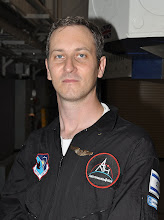A lot of ideas are depicted in movies - for example, the talking (and treacherous) computer HAL in "2001: A Space Odyssey" or the friendlier one in StarTrek. Other imagined interfaces are elaborate touch screen interfaces (StarTrek) or hand waving wearing special gloves in "Minority Report" (hey, it looked good on Tom Cruise, why not Nicole Stott or Robert Satcher?).
There are numerous computer interfaces at our disposal today. The most prevalent type consists of the windows paradigm (note lower case 'w') - Mac OS X, Windows and Linux, all descendants of concepts envisioned in the 1940s and developed in the early 1970s. Controling such environments is done in various ways - the most abundant is the mouse and keyboard. Others exist, such as trackballs, touch screens (single-touch and the newer and more useful multi-touch) and touchpads. Mobile platforms such as the iPhone are getting an ever growing role as input and interaction devices, communicating wirelessly with computers and networks.
Bolder attempts to break the mold are surface computing (for example, Microsoft Surface) all the way to a "sixth sense" as shown in TED 2009 and Bill Gates' smart home, where the faucet recognizes your face.
With this plethora of science fiction ideas and actual advanced interfaces, it doesn't seem right that astronauts have to use laptops through keyboards and touchpads in odd (very non-ergonomic, just look on the right) positions. Yes, these laptops are much more advanced than the Apollo era on-board computers, but interacting with them is not much better and definitely lags behind current offerings on Earth. Where are the big touch screens embedded in the walls? Why can't astronauts ask "Computer, are there any leaks in hatch number 2?" and get an answer "Hatch number 2 is secure. No leaks were detected." in a friendly voice?
At least for the second question there is a partial answer - Clarissa. In 2005 a computer program called Clarissa was put in use at the ISS. Its purpose was to help conducting water tests through voice instructions and speaking the results. Oddly, there doesn't seem to be any record of it beyond 2005.
What does the future hold? With the space station scheduled to deorbit in 2016, it is unlikely it will be revamped and look anywhere close to the NCC-1701D. It will be exciting to see what of the current human machine interface technologies will make it to the next step in space exploration.
Maybe astronauts will just need to think about the command like the OpenViBE project aims for or even have some fun interacting with the computer with technologies like Microsoft Project Natal.




 Space Shuttle Launch Poll Results
Space Shuttle Launch Poll Results












4 comments:
Very interesting reading. Thanks! I think there is so much attention on keep cost low that the details of user interface get lost. That's the problem with most research-based outfits, including NASA. If you want something to be polished, it needs to get out of the research phase and get into production.
Since computers advance faster than space exploration vehicles (and that's an understatement), and I'm sure it is a lengthy process to certify a system for launch, I believe (and hope) we'll see different input mechanisms in the next generation vessels. Embedding touch screens in the walls or to prevent 'cabinet space waste' screens that pull out of the wall horizontally and have hinges is a logical next step IMHO. Heck, maybe they can watch a movie on those or wake up the crew with a fake sunrise on the display...
You need to apply pressure on a touch screen to use it. This might be a problem in microgravity.
Ori, that's an interesting thought, but you also need to apply pressure to a keyboard and touchpad, which is what astronauts use today.
And if we take it a little further, you won't really need to touch it (technologies used in the Nintendo Wii remote are a crude example for control with no touch).
Post a Comment